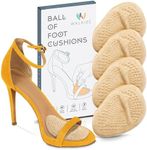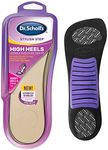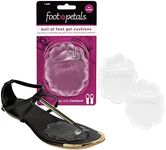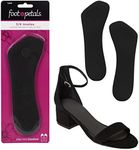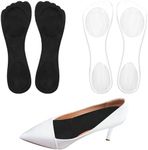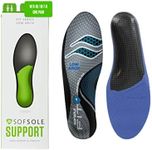Buying Guide for the Best Insoles For High Heels
Choosing the right insoles for high heels can make a huge difference in comfort, support, and how long you can wear your shoes without pain. Insoles are designed to cushion your feet, reduce pressure on sensitive areas, and help prevent common issues like blisters or sore spots. When shopping for insoles, it's important to consider your specific needs, such as the type of high heels you wear, how long you wear them, and any foot problems you may have. Understanding the key features will help you find the best fit for your lifestyle and comfort.MaterialThe material of the insole affects both comfort and durability. Common materials include gel, foam, and leather. Gel insoles are soft and provide excellent shock absorption, making them great for people who stand or walk a lot in heels. Foam insoles offer cushioning and can mold to the shape of your foot, which is helpful for general comfort. Leather insoles are more breathable and can help with moisture control, but may not offer as much cushioning. Think about how much padding you need and whether your feet tend to get hot or sweaty when choosing the material.
Arch SupportArch support refers to how much the insole helps support the natural curve of your foot. High heels often lack proper arch support, which can lead to foot fatigue or pain. Insoles can range from flat (minimal support) to contoured (strong support). If you have high arches or experience arch pain, look for insoles with more pronounced support. If your feet are generally comfortable, a moderate or low level of support may be enough. Your foot shape and any existing discomfort should guide your choice here.
Cushioning ThicknessCushioning thickness is about how much padding the insole provides. Thicker insoles offer more comfort but can make your shoes feel tighter, especially in high heels with limited space. Thin insoles fit more easily and are less likely to crowd your toes, but may not provide as much relief. If your shoes are already snug, opt for a thinner insole. If you have extra room or need more shock absorption, a thicker insole might be better. Always consider the fit of your shoes when deciding on thickness.
Heel and Ball of Foot PaddingHigh heels put extra pressure on the ball of your foot and your heel, so some insoles have extra padding in these areas. This targeted cushioning can help prevent pain and blisters where you need it most. If you often feel discomfort in the front or back of your foot, look for insoles that specifically mention extra padding in these zones. If your pain is more general, a full-length insole with even cushioning may be sufficient.
Shape and SizeInsoles come in different shapes and sizes to fit various types of high heels, from stilettos to wedges. Some are full-length, while others are just pads for the ball of the foot or heel. Make sure the insole matches the style of your shoe and doesn't stick out or move around. If you wear open-toe or strappy heels, choose a discreet, smaller insole. For closed-toe shoes, a full-length insole can offer more overall support. Always check that the insole fits securely and comfortably in your shoe.
AdhesionAdhesion refers to how well the insole stays in place inside your shoe. Some insoles have a sticky or grippy bottom to prevent slipping, while others are simply placed inside. If you move a lot or your insoles tend to shift, look for options with adhesive backing. If you want to switch insoles between different pairs of shoes, a non-adhesive type may be more convenient. Your activity level and how often you change shoes can help you decide which is best.
